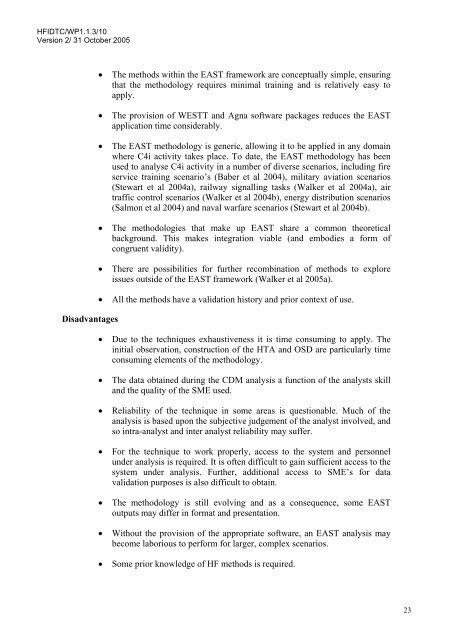A Review of the Event Analysis of Systemic Teamwork Methodology
A Review of the Event Analysis of Systemic Teamwork Methodology
A Review of the Event Analysis of Systemic Teamwork Methodology
- No tags were found...
Create successful ePaper yourself
Turn your PDF publications into a flip-book with our unique Google optimized e-Paper software.
HFIDTC/WP1.1.3/10<br />
Version 2/ 31 October 2005<br />
Disadvantages<br />
• The methods within <strong>the</strong> EAST framework are conceptually simple, ensuring<br />
that <strong>the</strong> methodology requires minimal training and is relatively easy to<br />
apply.<br />
• The provision <strong>of</strong> WESTT and Agna s<strong>of</strong>tware packages reduces <strong>the</strong> EAST<br />
application time considerably.<br />
• The EAST methodology is generic, allowing it to be applied in any domain<br />
where C4i activity takes place. To date, <strong>the</strong> EAST methodology has been<br />
used to analyse C4i activity in a number <strong>of</strong> diverse scenarios, including fire<br />
service training scenario’s (Baber et al 2004), military aviation scenarios<br />
(Stewart et al 2004a), railway signalling tasks (Walker et al 2004a), air<br />
traffic control scenarios (Walker et al 2004b), energy distribution scenarios<br />
(Salmon et al 2004) and naval warfare scenarios (Stewart et al 2004b).<br />
• The methodologies that make up EAST share a common <strong>the</strong>oretical<br />
background. This makes integration viable (and embodies a form <strong>of</strong><br />
congruent validity).<br />
• There are possibilities for fur<strong>the</strong>r recombination <strong>of</strong> methods to explore<br />
issues outside <strong>of</strong> <strong>the</strong> EAST framework (Walker et al 2005a).<br />
• All <strong>the</strong> methods have a validation history and prior context <strong>of</strong> use.<br />
• Due to <strong>the</strong> techniques exhaustiveness it is time consuming to apply. The<br />
initial observation, construction <strong>of</strong> <strong>the</strong> HTA and OSD are particularly time<br />
consuming elements <strong>of</strong> <strong>the</strong> methodology.<br />
• The data obtained during <strong>the</strong> CDM analysis a function <strong>of</strong> <strong>the</strong> analysts skill<br />
and <strong>the</strong> quality <strong>of</strong> <strong>the</strong> SME used.<br />
• Reliability <strong>of</strong> <strong>the</strong> technique in some areas is questionable. Much <strong>of</strong> <strong>the</strong><br />
analysis is based upon <strong>the</strong> subjective judgement <strong>of</strong> <strong>the</strong> analyst involved, and<br />
so intra-analyst and inter analyst reliability may suffer.<br />
• For <strong>the</strong> technique to work properly, access to <strong>the</strong> system and personnel<br />
under analysis is required. It is <strong>of</strong>ten difficult to gain sufficient access to <strong>the</strong><br />
system under analysis. Fur<strong>the</strong>r, additional access to SME’s for data<br />
validation purposes is also difficult to obtain.<br />
• The methodology is still evolving and as a consequence, some EAST<br />
outputs may differ in format and presentation.<br />
• Without <strong>the</strong> provision <strong>of</strong> <strong>the</strong> appropriate s<strong>of</strong>tware, an EAST analysis may<br />
become laborious to perform for larger, complex scenarios.<br />
• Some prior knowledge <strong>of</strong> HF methods is required.<br />
23
















